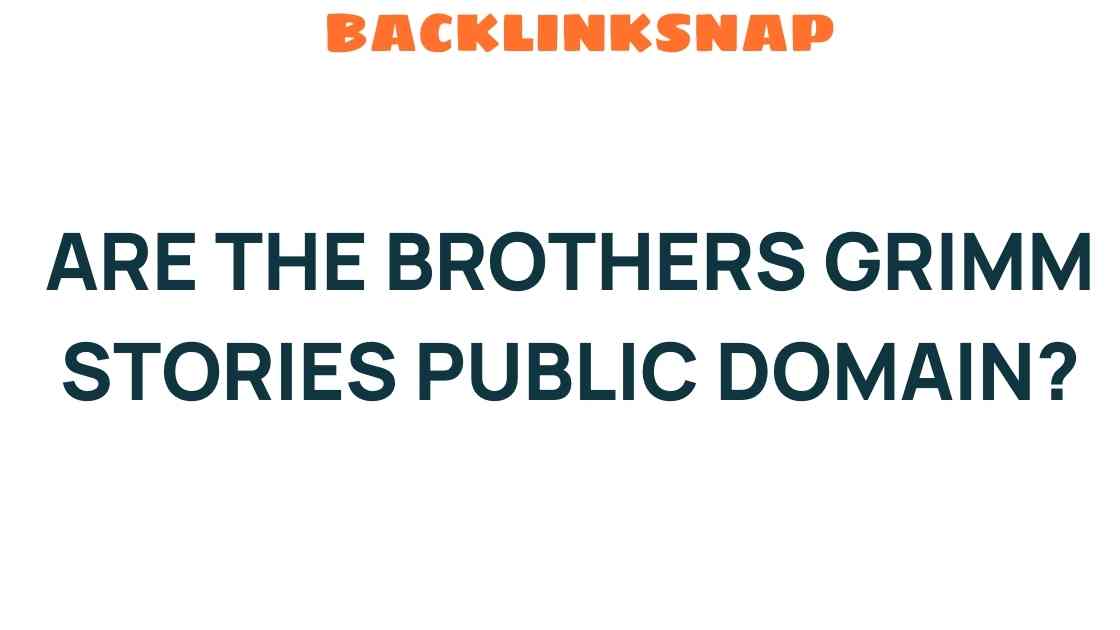Are the Brothers Grimm Stories Public Domain?
When we think of fairy tales, images of enchanted forests, charming princesses, and cunning villains often come to mind. Much of this imagery can be traced back to the iconic stories collected by the Brothers Grimm, Jacob and Wilhelm, whose works have captivated audiences for over two centuries. But as we delve into these beloved tales, a pressing question arises: Are the Brothers Grimm stories public domain? Unraveling this legal mystique requires an understanding of copyright laws, literary heritage, and the evolution of folklore.
The Brothers Grimm: A Brief Overview
The Brothers Grimm were German scholars and folklorists who began their work in the early 19th century. Their most famous collection, “Grimm’s Fairy Tales,” first published in 1812, includes stories such as “Cinderella,” “Snow White,” and “Hansel and Gretel.” Initially intended for a scholarly audience, these tales were later adapted for children, thus cementing their place in popular culture. As avid collectors of folklore, the Grimms sought to preserve Germany’s oral traditions and cultural heritage, making their work invaluable to the understanding of literary history.
The Concept of Public Domain
Before diving into the specifics of the Brothers Grimm, it’s essential to grasp what public domain means. Works that are in the public domain can be freely used, reproduced, and distributed by anyone without the need for permission or payment. This status typically applies to works whose copyright has expired or that were never eligible for copyright protection in the first place.
Copyright Laws and the Brothers Grimm
The copyright status of the Brothers Grimm stories is a fascinating journey through history. In the United States, the copyright laws that apply today were influenced by earlier statutes and treaties. The original publication of “Grimm’s Fairy Tales” occurred in 1812, a time when copyright laws were significantly different from today’s standards.
In most countries, including the United States, copyright protection lasts for a specific duration, generally the life of the author plus an additional number of years—commonly 70 years. However, since the Grimms passed away in the 19th century, their works have long since entered the public domain. As a result, the Brothers Grimm stories are indeed public domain, allowing anyone to adapt, reinterpret, and share these timeless tales without legal repercussions.
The Evolution of Fairy Tales and Folklore
The tales collected by the Brothers Grimm were not original creations but rather adaptations of existing folklore. Fairy tales, as a genre, have evolved over centuries, often changing with cultural shifts and societal norms. The Grimms themselves edited their stories over time, with later editions featuring more sanitized versions aimed at children.
This evolution raises questions about the integrity of the original tales. While the Grimms’ adaptations have become canonical, the roots of these stories often lie in oral traditions that predate the brothers themselves. For instance, “Little Red Riding Hood” has multiple variations across cultures, each reflecting local customs and morals.
Impact on Literary Heritage
The public domain status of the Brothers Grimm tales has had a profound impact on literary heritage. With no restrictions on their use, these stories have inspired countless adaptations, from films and musicals to novels and graphic novels. Disney’s adaptations of these tales have introduced them to new generations, albeit with significant modifications. The accessibility of the original texts allows for a richer exploration of their themes and morals, encouraging critical thinking and creativity.
Modern Reinterpretations and Cultural Significance
Today, the public domain status of the Brothers Grimm stories invites modern creators to explore these narratives in innovative ways. Authors, filmmakers, and artists can reimagine these tales, infusing contemporary issues and perspectives into classic narratives. This creative freedom has resulted in diverse interpretations, from feminist retellings to dark, gritty versions that challenge traditional norms.
Furthermore, the ability to freely use these stories contributes to a broader cultural dialogue about folklore and its relevance in today’s society. By examining the underlying themes of morality, justice, and human nature within the Grimm tales, we can gain insights into the values of different cultures and time periods.
FAQs About the Brothers Grimm and Public Domain
- Are all Brothers Grimm stories in the public domain?
Yes, all original stories collected by the Brothers Grimm are in the public domain, as they were published more than 100 years ago. - Can I adapt a Brothers Grimm story for my own use?
Absolutely! Since these stories are in the public domain, you can adapt them in any way you like without seeking permission. - What if I use a modern retelling of a Brothers Grimm story?
Modern adaptations may still be under copyright protection. If you wish to adapt a specific retelling, check the copyright status of that version. - Where can I find the original texts of Brothers Grimm stories?
You can find the original texts of the Brothers Grimm stories in various online archives and libraries, such as Project Gutenberg. - Why are fairy tales important to culture?
Fairy tales reflect societal values, beliefs, and fears. They serve as a means of teaching lessons, preserving history, and fostering creativity. - How have Brothers Grimm stories influenced modern literature?
These stories laid the groundwork for the fairy tale genre, inspiring countless authors and filmmakers to explore themes of adventure, morality, and the human experience.
Conclusion
In conclusion, the Brothers Grimm stories are indeed in the public domain, a status that has allowed their enchanting narratives to flourish and evolve over the years. Their tales, rich with cultural significance and moral lessons, continue to resonate with audiences today. As we navigate the complexities of copyright laws and intellectual property, it’s essential to celebrate the literary heritage the Brothers Grimm have gifted us. Their stories not only entertain but also invite us to reflect on the human condition across time and culture. So go ahead—explore, adapt, and enjoy the magic of these timeless fairy tales!
This article is in the category Digital Marketing and created by BacklinkSnap Team




